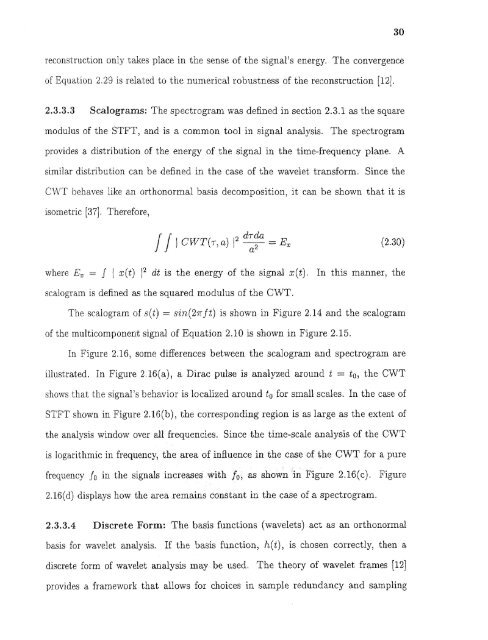Space/time/frequency methods in adaptive radar - New Jersey ...
Space/time/frequency methods in adaptive radar - New Jersey ...
Space/time/frequency methods in adaptive radar - New Jersey ...
Create successful ePaper yourself
Turn your PDF publications into a flip-book with our unique Google optimized e-Paper software.
30reconstruction only takes place <strong>in</strong> the sense of the signal's energy. The convergenceof Equation 2.29 is related to the numerical robustness of the reconstruction [12].2.3.3.3 Scalograms: The spectrogram was def<strong>in</strong>ed <strong>in</strong> section 2.3.1 as the squaremodulus of the STFT, and is a common tool <strong>in</strong> signal analysis. The spectrogramprovides a distribution of the energy of the signal <strong>in</strong> the <strong>time</strong>-<strong>frequency</strong> plane. Asimilar distribution can be def<strong>in</strong>ed <strong>in</strong> the case of the wavelet transform. S<strong>in</strong>ce theCWT behaves like an orthonormal basis decomposition, it can be shown that it isisometric [37]. Therefore,where Ex f x(t) 2 dt is the energy of the signal x(t). In this manner, thescalogram is def<strong>in</strong>ed as the squared modulus of the CWT.The scalogram of s(t) s<strong>in</strong>(2πƒt) is shown <strong>in</strong> Figure 2.14 and the scalogramof the multicomponent signal of Equation 2.10 is shown <strong>in</strong> Figure 2.15.In Figure 2.16, some differences between the scalogram and spectrogram areillustrated. In Figure 2.16(a), a Dirac pulse is analyzed around t to , the CWTshows that the signal's behavior is localized around t o for small scales. In the case ofSTFT shown <strong>in</strong> Figure 2.16(b), the correspond<strong>in</strong>g region is as large as the extent ofthe analysis w<strong>in</strong>dow over all frequencies. S<strong>in</strong>ce the <strong>time</strong>-scale analysis of the CWTis logarithmic <strong>in</strong> <strong>frequency</strong>, the area of <strong>in</strong>fluence <strong>in</strong> the case of the CWT for a pure<strong>frequency</strong> ƒo <strong>in</strong> the signals <strong>in</strong>creases with fo , as shown <strong>in</strong> Figure 2.16(c). Figure2.16(d) displays how the area rema<strong>in</strong>s constant <strong>in</strong> the case of a spectrogram.2.3.3.4 Discrete Form: The basis functions (wavelets) act as an orthonormalbasis for wavelet analysis. If the basis function, h(t), is chosen correctly, then adiscrete form of wavelet analysis may be used. The theory of wavelet frames {12]provides a framework that allows for choices <strong>in</strong> sample redundancy and sampl<strong>in</strong>g
















